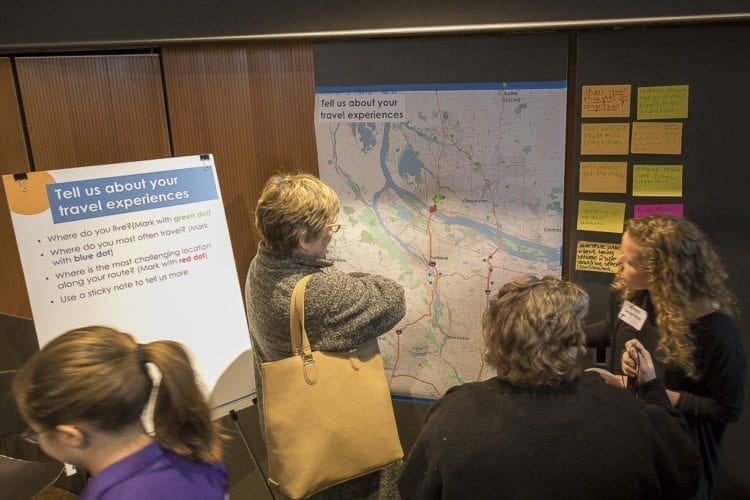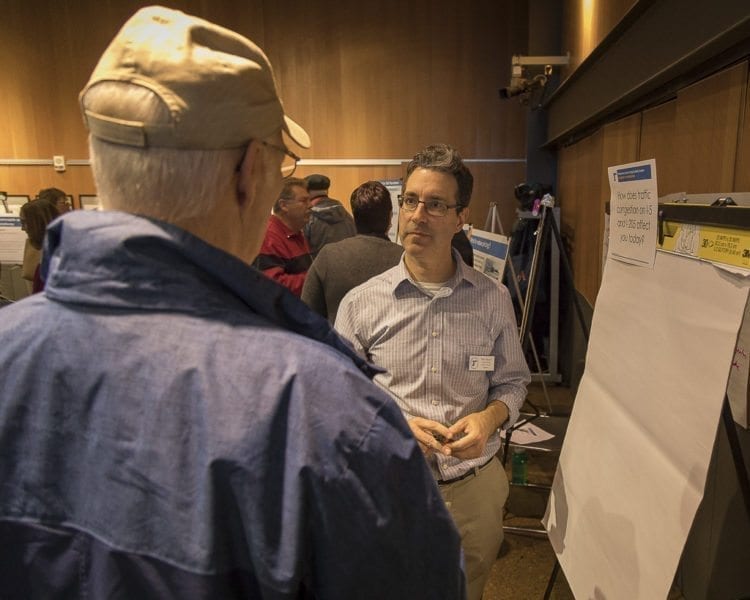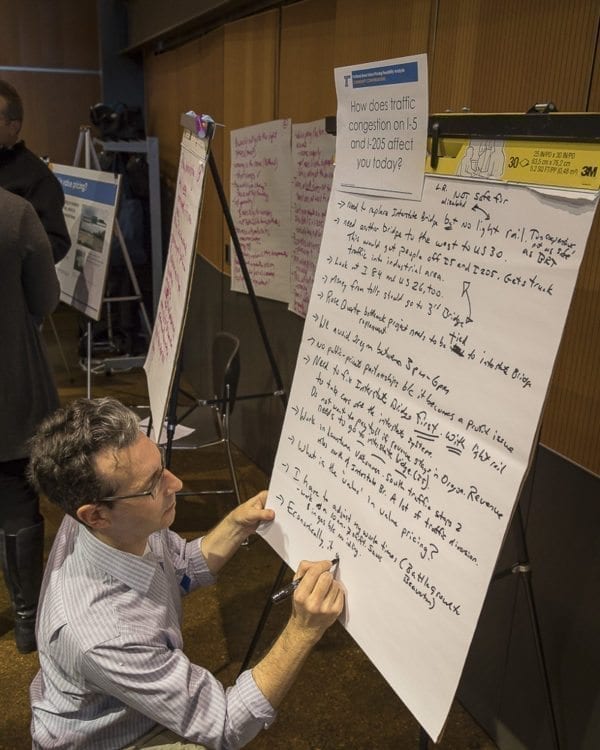ODOT open house provides information and gathers feedback on interstate toll proposal
VANCOUVER — Congestion along I-5 and I-205 is a problem that is only growing, both in Clark County itself and across the Columbia River in Oregon. To alleviate the congestion on the Oregon side of the river, the Oregon Department of Transportation (ODOT) is examining value pricing, or tolls, on parts of I-5 and I-205.
Value pricing would affect Clark County residents due to the large number of citizens that commute to work in Portland on a daily basis. Recognizing this, the Oregon Traffic Commission established a Portland Region Value Pricing Policy Advisory Committee last fall to collect feedback and make recommendations during a feasibility analysis for value pricing.

The committee is made up of 25 members, and three are from Southwest Washington, including Vancouver Mayor Anne McEnerny-Ogle, Clark County Council Member Eileen Quiring and a WSDOT representative.
On Tue., Jan. 30, the committee held an open house at the Vancouver Community Library to provide answers to the public as well as collect feedback from Clark County residents about the tolling proposed for the interstates.
According to information provided by ODOT, in 2017, the Oregon legislature passed a bill that invests money into the state’s transportation system. The bill directed the Oregon Transportation Commission to create a proposal that established value pricing as a way to alleviate congestion on Portland’s interstates.
To enact value pricing, the commission must ask for approval from the Federal Highway Administration by Dec. 31, 2018.
Value pricing is described by ODOT as “the implementation of a user fee to manage traffic congestion.” A higher fee is theoretically charged during times of the day that experience more congestion, and this, according to ODOT, makes some drivers choose to use alternate routes, different driving times and alternative forms of transportation like public transit.
According to Don Hamilton, public information officer for ODOT’s Region 1, the open house was designed to give Clark County residents a chance to “know what these problems are about.”
“Nobody likes congestion and nobody likes traffic,” Hamilton said. “This is an effort to try to do something about it.”


Hamilton said that value pricing can consist of several different approaches. One is to establish a toll lane, another is to toll all lanes of a highway. By encouraging drivers to adjust their commute times, Hamilton said that congestion will be reduced with drivers spread out over different times of the day.
“The toll is basically an incentive that helps people to change their trips to different times of the day, to take different forms of transportation,” Hamilton said. He noted that money raised from tolls would go into a fund created by the Oregon State Legislature, but how that money would be used and for what specific projects has yet to be determined.
At the open house, attendees had a chance to speak to ODOT representatives and ask questions and voice concerns about the tolling proposal. Information stations were provided, and visitors could write down their concerns or experiences with congestion along the interstates. Further, attendees could answer questionnaires provided by ODOT representatives.
Attendees had the chance to voice their opinions on tolls, and several that did were not happy with the proposal.
Camas resident John Ley said that there are many reasons why a majority of Clark County citizens are against value pricing. The approximately 70,000 Clark County residents that commute to Portland each day would “be paying more than their fair share of those tolls,” Ley said.
“Their whole goal is to inflict some financial pain and to find a point where if there’s enough pain people will get off I-5 and I-205,” Ley said. “Well where are those people going to go?” he asked, noting that forcing commuters off of the interstates will move them onto side streets that are already congested, thus making the problem worse.
Ley also expressed concerns about the collection of tolls. “Once they get the tolls started, they never stop,” he said. Ley asked whether the roads will be tolled at times of the day when there is no congestion, and cited a value pricing program in Virginia last fall that still had drivers paying $5.50 at 5:30 in the morning.
“We want something that improves congestion,” Ley said. “They’ve got to fix the real bottleneck on I-5 and that’s the Rose Quarter.”
According to Ley, the state of Oregon wants to spend approximately $450 million to address the highways in the Rose Quarter, but not add any new thru-lanes to the interstates. “That’s a sad waste of money,” he said, and noted that approximately half of the money would go to “community redevelopment,” such as services for bikes, pedestrians and transit.

Hamilton responded to Ley’s arguments and said that the $450 million Rose Quarter project is not directly related to the value pricing proposal, it instead comes from a bond passed by the state legislature and that the project is at least four years away from any sort of progress.
Hamilton also said that it would be a joint project between the city of Portland and the state of Oregon. It would add shoulders and auxiliary lanes to each side of the highway, which would create lanes that directly connect on and off ramps.
Other attendees also expressed anger at the Oregon proposal.
“I’m really mad about the toll proposal,” said Debbie Larner, calling it “blatant theft.” Larner said that with only two bridges over the Columbia River, she did not believe that the proposal would make much difference on congestion.
“We need more bridges,” Larner said, and that while officials in Oregon realize that, they do not like automobiles and simply want to gain more money. Instead of tolling the interstates, Larner said that Oregon should toll state and local routes used primarily by Oregon residents and drivers, rather than holding Washington commuters “hostage” to tolls.
Larner also said that the value pricing plan’s goal of encouraging alternate forms of transportation does not fit Clark County. She said that while buses may be good, light rail is expensive and not desired by many in Clark County.

Hazel Dell resident and Vancouver real estate agent Sue Pauley approached the issue of tolls from a real estate perspective. She said that with the added costs of commuting to Portland, people “will not be as anxious to buy here.” Increased costs for commuters already paying Oregon income tax may mean that less people will want to move to Clark County, Pauley said.
Having less people to sell real estate to would be “catastrophic” for the Clark County real estate industry, Pauley said, and that the toll will be a breaking point that pushes costs of working in Oregon beyond what is feasible for commuters looking to buy in the county.
Adding tolls to the interstates in Oregon would “deleteriously affect the real estate industry in Clark County,” Pauley warned.
Not everyone at the open house was opposed to tolls. Vancouver resident Mark Moors said that “this project needs to be funded one way or another,” and that growth had to be addressed by some means. He suggested a variety of possible solutions to congestion along the interstates, including bringing the MAX line light rail to Clark County and replacing the old I-5 bridge with a new structure.
Approximately 150 people attended the open house in Vancouver. Hamilton said that there is still more time before any final decision is made on value pricing. The committee must make recommendations to the Oregon Transportation Commission, which will then send a proposal to the federal government by the end of the year.
An online open house to provide feedback on the value pricing proposal is available through Feb. 5 at www.odotvaluepricing.org or via email at valuepricinginfo@odot.state.or.us.




